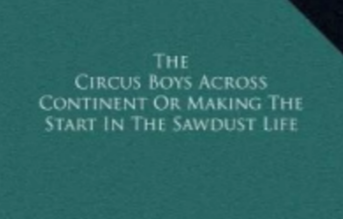CHAPTER V — The Circus Boys Across the Continent
byCHAPTER V — The Circus Boys Across the Continent begins as Phil Forrest is suddenly thrust into a dangerous situation high above the circus floor. While being lifted on the key rope during tent setup, his body gains alarming speed, and he’s nearly hurled into the iron framework of the dome. Realizing the risk, Phil instinctively wraps the rope around the center pole, creating friction to slow his ascent. His quick thinking prevents a deadly impact, but the tension in the air doesn’t ease. From below, eyes widen in horror as the iron ring at the top of the canvas shifts, its weight threatening to pull Phil either into the rigging or send him tumbling over forty feet. Mr. Sparling, recognizing the seriousness of the danger, immediately orders his crew to prepare the net—one misstep, and Phil would be lost to a fall few could survive.
Shouting from below urges Phil to let go, but he remains locked in place. The canvas above him would collapse if he released the tension, potentially injuring crew members still at work. With impressive focus, he presses his feet against the iron ring to support the weight of the structure, using both strength and strategy to hold the tent steady. This silent act of bravery speaks volumes about his character. While panic spreads on the ground, Phil remains composed, understanding the risk he’s taking to protect everyone below. The circus isn’t just a place for entertainment—it’s a world where each person depends on the next. In this moment, Phil places the welfare of his team above his own safety, reinforcing the bond of trust that holds the show together.
A new idea sparks as Phil calls for another rope to be tossed up. Several attempts fail, heightening the tension, but at last, a suitable rope reaches his grasp. Without hesitation, he threads the new line through the loop in the key rope, skillfully creating a secure knot that begins shifting the weight of the tent from his body. This single maneuver, done under pressure, turns the tide. Gradually, he redistributes the load, making it possible for the team below to take on more of the burden. His actions display not only physical endurance but also problem-solving under duress—traits that mark him as more than just a performer. He is now proving himself as a problem-solver when it matters most.
Mr. Sparling quickly realizes what Phil is attempting and acts accordingly. With help from the rigging team, they use a side pole to manipulate the ropes, steadily lowering the loop. This action decreases the pressure on Phil, allowing him to breathe and reposition himself safely. The safety net, while still in place, becomes less of a last resort and more of a comfort as the plan unfolds successfully. Relief washes over the workers as the structure stabilizes, and Phil is gently brought down amid applause and sighs of gratitude. The danger passes, but the memory of his courage will remain with everyone who witnessed it.
Back on solid ground, Phil’s muscles ache and sweat pours down his face, but he wears a quiet smile. He downplays the danger, claiming he only did what needed to be done. Mr. Sparling, however, offers no such modesty. He places a hand on Phil’s shoulder and tells the surrounding crew that what they saw was true courage—courage that isn’t rehearsed or rewarded on stage but that keeps the circus running. Others nod in agreement, some clapping, others silently looking on with new respect. The act wasn’t in the ring, but it earned Phil something more meaningful than cheers: trust.
As the team resets and prepares for the next task, the incident becomes the story of the day. Teddy, ever the jokester, spins a wildly exaggerated version of the event for newcomers, describing Phil as “a spider-man of the sawdust.” Yet beneath the humor lies real admiration. Phil’s selfless act is a reminder that circus life is more than spectacle—it’s built on shared responsibility, quick thinking, and a willingness to act when others freeze. In the tightly woven fabric of the circus family, moments like this are remembered and retold not for their drama, but for their meaning. Phil has not just faced danger—he’s risen to meet it with the strength of someone who belongs.

